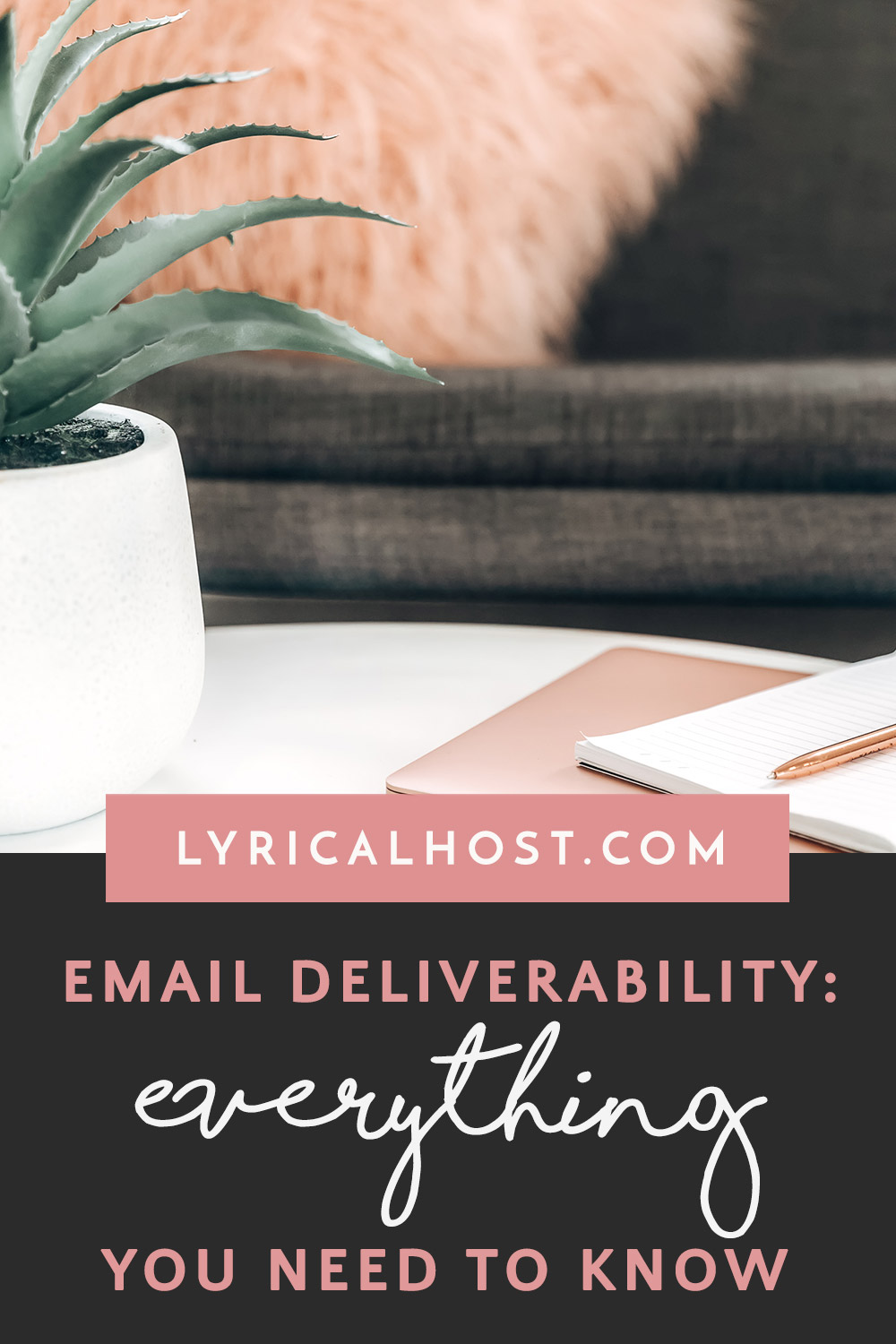Everyone wants their emails to get more opens and engagement, so in this post we break down the tech talk to help you make that happen!
Whether you’re sending to one person or emailing your list, we explain what factors determine whether or not your message goes to spam, plus tips and tricks to stop that happening.
Side note: If you’re a Lyrical Host customer, there’s a handy at-a-glance “Email Deliverability Checklist” in the Resource Library.
Currently reading: Everything You Need To Know About Email Deliverability Click To TweetWhat’s the difference between “delivery” and “deliverability”?
Delivery – This relates to whether an email is literally sent and received (or not). For example, if you try to send an email to an account that doesn’t exist, it won’t be received (delivered).
Deliverability – This refers to where your email ends up when delivered. For example it could end up in the primary inbox folder, spam/junk, a promos folder, or somewhere else. Good deliverability means landing in front of the recipient’s eyes without them having to check their spam or move things around.
Deliverability factors
So what determines where an email ends up?
There are lots of different factors involved, but generally speaking they fall into two main areas: technical and content.
Like putting together a jigsaw puzzle, a provider will piece together bits of information to determine whether or not an email is legitimate and wanted.
These factors will either increase or decrease the spam score of an individual email, with different providers giving different weights to different factors, and the overall score is compared against the individual email provider’s spam thresholds. For example, for one provider a value of 5 might result in the email being filtered to the spam folder and a value of 0 or less might result in the email being outright rejected, whereas for another provider a value of 7 or less might result in the email being filtered to spam.
Technical/Domain Factors
There are some settings you can check/implement to make sure you’re sending strong legitimate signals to email providers, plus an overall score of how they see you.
Identification – There are three email protocols that are used to verify and authorize whether your email looks legitimate: SPF, DKIM and DMARC. We’ll explain more about these and how to set them up later on in this post.
Blacklisted IPs – Email providers will often make use of IP blacklist services which list mailserver IP addresses that have been blacklisted due to the volume of spam emails they’ve sent out. This allows email providers to easily filter out mail from blacklisted mailservers.
Content Factors
This covers every aspect of your email’s content, from your subject line to images. The good news is that you have very fine-grain control over all these things; the bad news is that it’s easily possible to accidentally hit a spam trigger and have a provider treat your email as potential unwanted promotion even when it’s not.
Fundamentally, it comes down to what your email is about, and whether it will be recognizable to the recipient as something interesting/helpful (i.e. not spammy). There are a whole bunch of ways you can make your email content pass deliverability checks and improve your reputation, which we’ll cover below.
How can I reduce the chances of my emails going to spam?
This advice applies whether you’re sending a regular email to one person, or emailing a list.
Optimizing for technical factors
As mentioned above, there are three main types of email records that handle identification and verification: SPF, DKIM, and DMARC.
SPF – See How to set up SPF records. (This is the most important one to set up, as not all email hosts use DKIM and DMARC records).
DKIM – See How to set up DKIM records.
If you need help and you’re a Lyrical Host customer, please raise a support ticket with details of where you’re at and where you got stuck.
DMARC – This provides some options for handling mail that doesn’t pass legitimacy checks (e.g. whether it’s completely rejected or just sent to spam). See How to set up DMARC records (you’ll want to set these up after your SPF and DKIM records).
A side note on mailing list providers – Mailing list providers such as Mailerlite and Convertkit typically have a set up step which walks you through identification settings and records when you first sign up with them, so it’s likely you don’t need to change anything for this.
Deliverability optimization for email content
Watch your language – Any profanities, mild curse words or offensive language can be a red flag.
Use plain text if possible – It’s not always what you want to do, but stripping all formatting from your emails and just using plain text (no links, images, or colors), can be worth trying if you’re finding your emails are landing in junk.
Check your ratios for formatted emails – If you choose to use HTML and format your emails for styling reasons, check your ratio of regular text to images/links/code. The more images, links and formatting code you have in your emails, the more human-readable text you need to balance it out.
A suspicious looking email may just have a short sentence or no words at all, as it’s trying to make you curious to click on a suspicious link or attachment. So to show that your email is legitimate, include more readable text.
Avoid attachments – Unless the recipient knows you and is expecting an attachment, avoid adding anything to your emails. Attachments can mean your email is more likely to go to spam or not be trusted by the recipient.
Don’t use images as a replacement for text – This is a good rule of thumb in general, as it’s bad for accessibility. For emails, having text on your images is also problematic because many people have images blocked by default in their mail client. Plus, it reduces the amount of actual text you have in your text: everything else ratio (as mentioned above).
Make sure to include ALT text on any images in your email – As well as being better for accessibility, it’s also used as a trust factor.
Check your signature – It can be easy to forget or overlook, and it’s super important to check as it can affect the deliverability of every email you send. If your signature is very code-, link-, or image-heavy, it’s worth seeing if you can simplify it. This also has the advantage of making it easier for a recipient to decide what to click – you don’t need a link to each and every social media profile you have in there.
Consider your subject line – It’s the main factor in someone deciding whether or not to open your email, but it’s also used in determining deliverability. Making sure there’s no bad language, checking it appeals and makes sense to a human reader (to reduce the risk of being flagged as spam), and avoiding confusing special characters can all help.
If you’re sending to a mailing list – Make sure you have an easy to find unsubscribe link, and include your physical mailing address in the email. These are required by international law.
Reducing the chances of spam reports
Your reputation relies on happy subscribers, so this section is all about reducing the likelihood of people reporting or marking your emails as spam. As a bonus, keeping a trim list means most of the below will save you money over time, too!
Clean your list regularly
A clean mailing list (and for individual email sending, clean contact list) are key to your reputation. Many of the other points in this section help you create and maintain a clean list.
Check how your sender name is presented
For example, if you land in people’s inboxes as “marketing@yourbusiness.com,” people may be more likely to see it as a promotional email and ignore it or send it to junk. Using your first name makes your email feel more personal straightaway. At Lyrical Host, I have my sender name set as “Jenni at Lyrical Host,” so that people also have the reminder/association of the company name for extra context.
Send occasional reminders
Many mailing list providers have a feature to let you ask people who haven’t opened your emails in a long time if they still want to remain on your list. This allows them to “opt in” again, or automatically removes them after a set period of time if they don’t. It’s a great way to clean an old list, check if email addresses are still in use, or otherwise remove passive subscribers. It also reduces the chances of your emails being marked as spam by subscribers.
Use double opt-in
Single opt-in attracts a ton of spam sign ups, and bots are never going to read your emails or buy from you. Having an extra step for people to confirm they want to be added to your list also means that they’re already seeing your emails (they’re not going to your spam and forgotten from the start) and shows they have more commitment. Double opt-in also gives you proof that someone has confirmed they are interested in receiving your emails should this ever be raised as a data privacy concern or if they happen to request the specific details of when/how they signed up.
Unsubscribe duplicates
If you don’t have a huge list or your mail provider has great search tools, search for duplicate first and last names. You may be able to identify people who have subscribed multiple times because they’ve forgotten, and unsubscribe them if they regularly don’t open your email from the other address/es.
Fine-tune frequency and interest
Consider segmenting or grouping your mailing list subscribers (most providers should give you this option) so that people only receive the emails most interesting to them.
Some mailing list providers have a feature where your subscribers can choose to opt out of specific campaigns (for example Valentine’s Day) without completely unsubscribing from your list.
This is especially useful if you have a variety of reasons why people may opt-in to your emails (for example to grab a download, because they joined your webinar or group a few years ago, or because you contributed to a collaborative summit or bundle),
Keep your account secure
Someone getting into your email account can send all kinds of spammy emails and get you blacklisted with different mail providers. Make sure you use a strong password and enable two-factor authentication. Take a look at our password security tips for further advice.
Comply with privacy laws
Various countries have data privacy laws that relate to emails (such as CalOPPA and GDPR). Complying with these laws is something that you’re likely doing already, such as not subscribing people to your emails without their permission, and including an unsubscribe link in emails to your mailing list, but it’s important to make sure you’re up to date with the requirements for being compliant with these laws.
Even if a particular set of laws doesn’t apply to you and your subscribers, it’s still a good idea to follow them for greater trust and peace of mind. Plus, it means less work in the future if your region decides to incorporate these laws.
While these factors may not directly affect your deliverability, it’s always good to reduce the chances of someone reporting your emails as spam.
Balance frequency and consider tone
Too many emails mean people are more likely to find them annoying; too few and they’ll forget who you are/that they signed up.
Where possible, try to send emails that people will find joyful or useful – aim to invoke happy emotions as opposed to fearmongering, stressful, manipulative, or annoying subject lines and content.
Make it easy to unsubscribe
On the surface it may seem counterproductive, but if you’re sending mailing list emails, don’t make your unsubscribe link too hard to find. As well as being good privacy practice, it reduces the chances of a subscriber reporting your email as spam through their email client instead (which is much worse than unsubscribing). Plus, if someone is never going to open your emails anyway, you’re spending money on them that you won’t get back if you’re making it hard to unsubscribe.
Frequently Asked Questions
When is it better to send emails via a mailing list provider vs from my own mail client?
If you’re sending emails to multiple people, and it’s not naturally part of a small group discussion (i.e. you’re sending a newsletter, sale email, content roundup or similar), it’s best sent through a dedicated mailing list provider.
This is because regular email is only designed for small numbers of recipients and lacks the management features required for lists, such as the ability to unsubscribe.
What is blacklisting and how do I tell if my emails are being blacklisted?
In the context of emails, an IP blacklist is a list of the IP addresses of mailservers that are known for sending out large volumes of spam emails. Email providers will often use a mix of third-party blacklist services and their own internal lists in order to build up a list of blacklisted IPs, and will then be much more likely to either filter an email directly to the spam folder, or outright reject it if the IP address of the mailserver that sent the email has been blacklisted.
There are a number of tools (such as MXToolbox) that can be used to check popular third-party blacklists in order to see whether your own email provider is currently blacklisted. If you do find that your domain’s mailserver IP is on a blacklist, you should contact your email provider to get them to fix this.
How important is my mailing list provider in determining whether my emails go to spam?
If you’re using a mailing list provider with an established reputation and they’re keeping on top of blacklisting, it’s unlikely to make much difference to your deliverability which provider you choose.
From time to time, all providers will see temporary blacklistings that affect deliverability, but this isn’t something to worry about unless you’re finding it happens frequently.
Why have I temporarily been blocked from sending emails?
Because of the risk of having their mailserver IP addresses blacklisted if they are known to send out a lot of spam emails, some email providers will have limits in place on the amount of spammy-looking emails a specific email address can send out before they will temporarily prevent that email address from being able to send out any emails. In some cases, it may be that you’re sending genuine emails, but they’re tripping filters – the best way to avoid this is by following the tips above.
If you find that you’re unable to send emails from your account you should contact your email provider to check if they’ve applied a temporary block to your email account, and what can be done to lift the block.
If I haven’t emailed my list in ages, how do I figure out if my list is still good/decide if I should ditch it and start again?
You could test the waters by emailing your subscribers about something related to what they originally signed up for, or explaining to them that you’re relaunching your list. Another option is to send them an email asking them to re-opt-in to receive future emails if they want to hear from you, but bear in mind that if the vast majority probably won’t (this could be a good thing for ensuring your list is clean, active and more likely to engage).
Found this post useful? Pin it for someone else:







No Comments